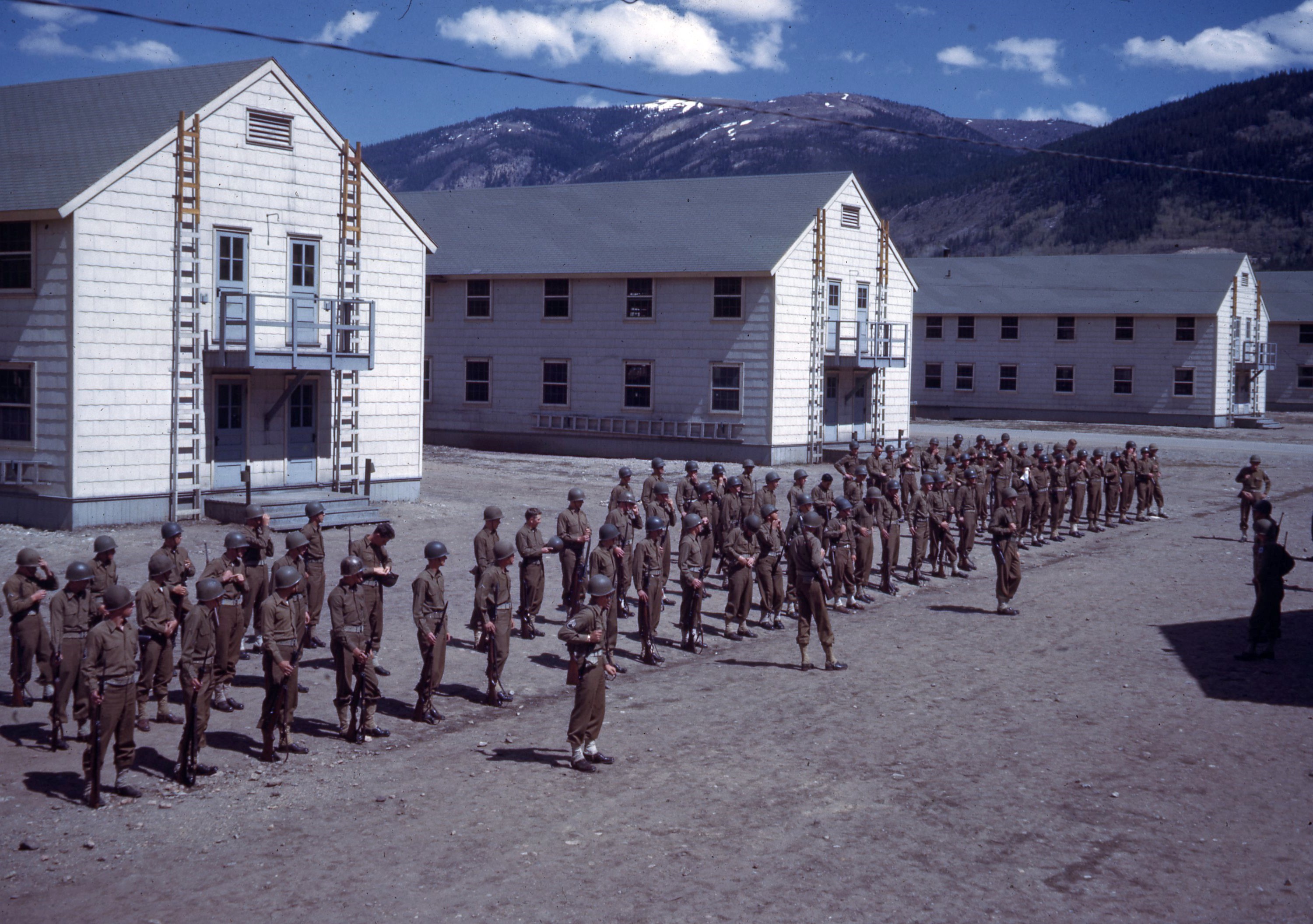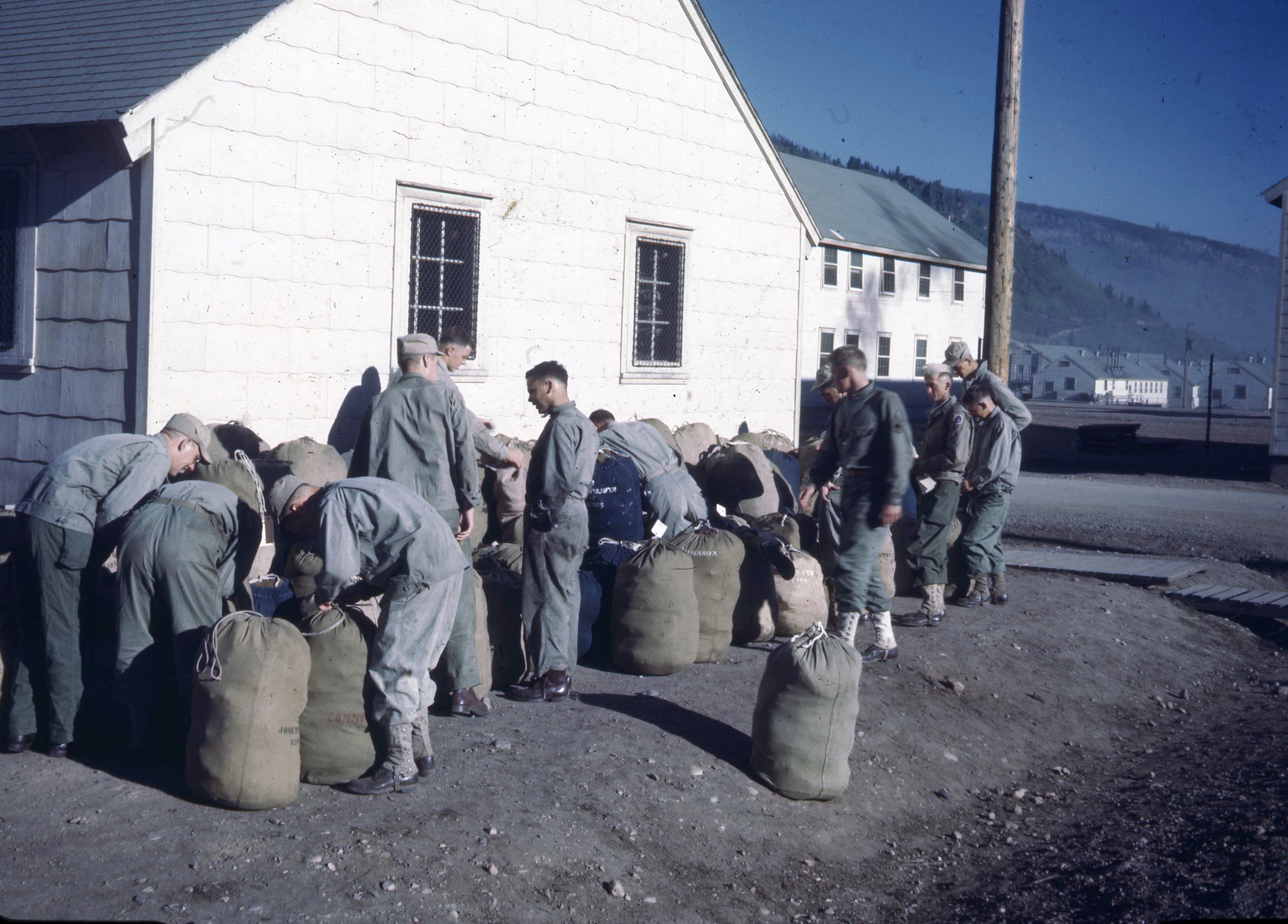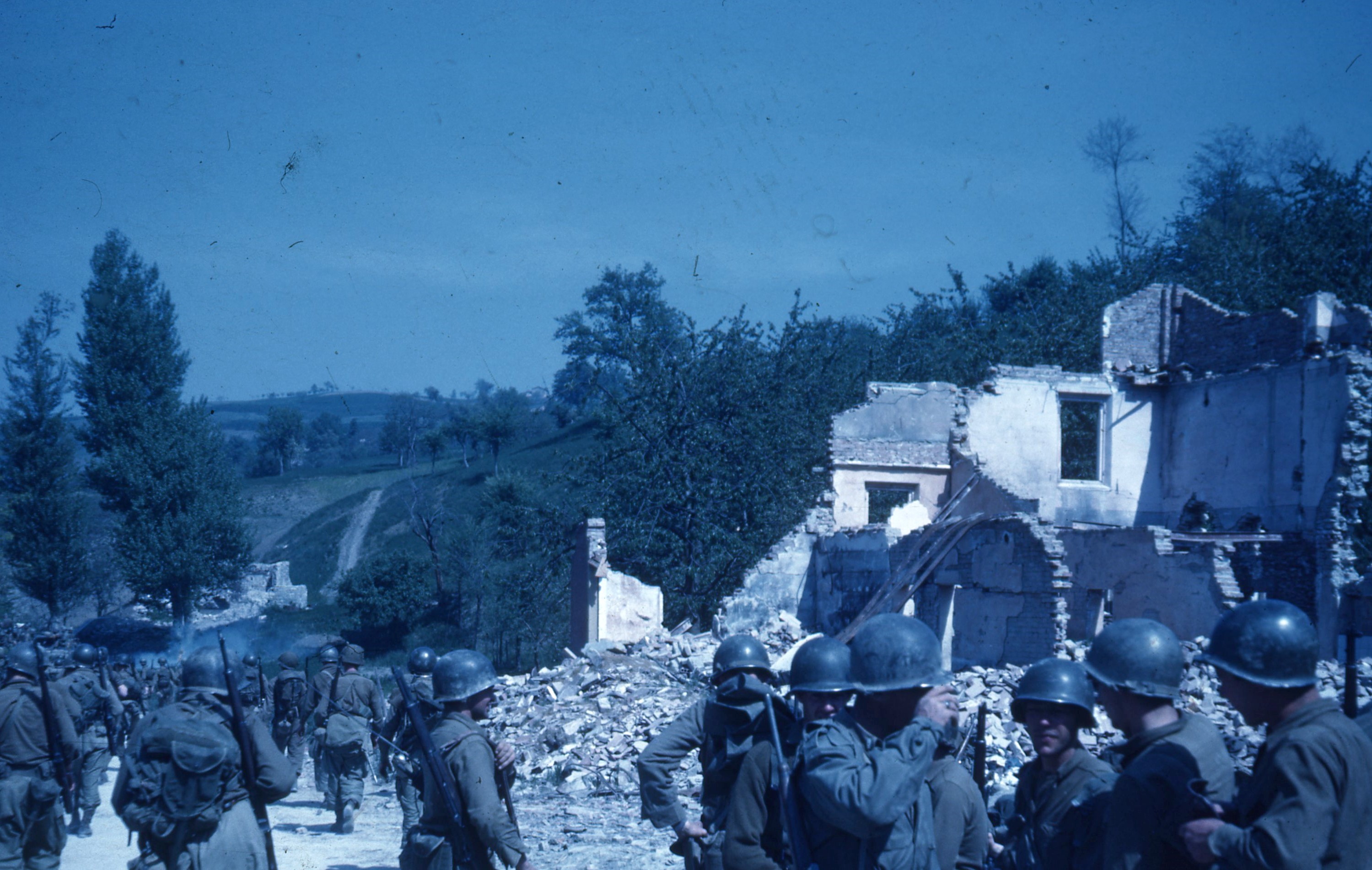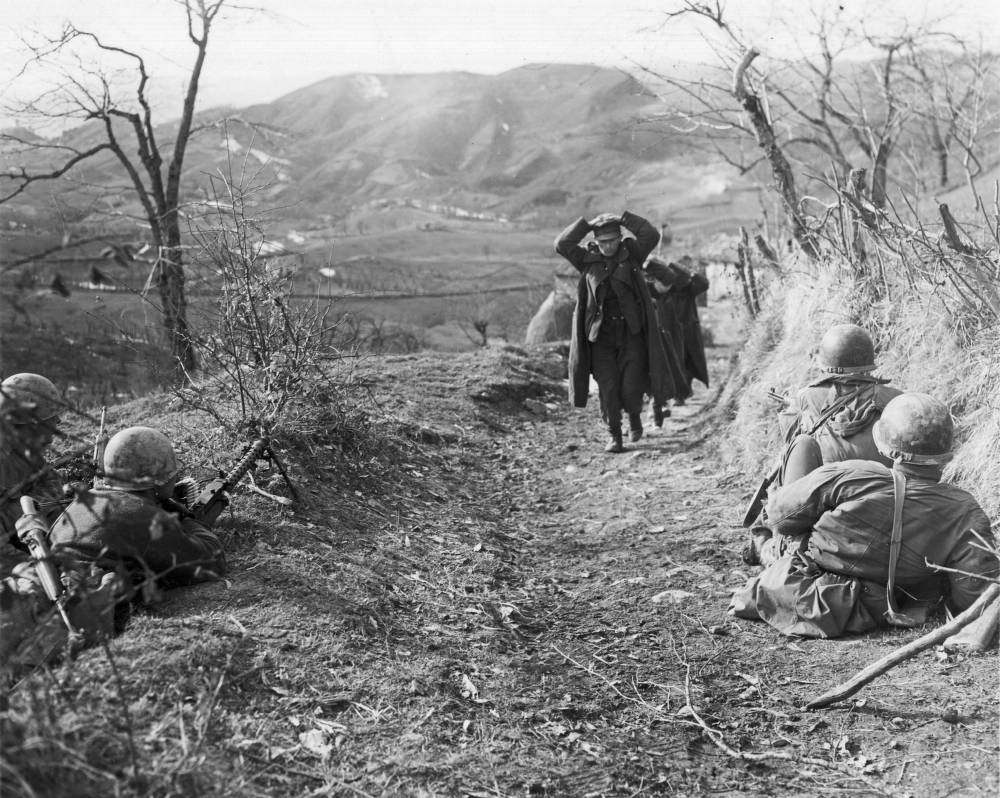
Story
Military Mountaineers
The 10th Mountain Division’s legendary breakthrough in the Italian Apennines.
The Allies were closing in on Nazi Germany in April of 1945. Soldiers on the Western Front had fought all the way across France, reached German soil, and were beginning to encircle the German Army. In the East, the Red Army was launching major offensives against both Vienna and Berlin. In northern Italy, where fascist dictator Benito Mussolini had been reduced to the figurehead of a German puppet state, the Allies had assembled a multinational force to punch through the last defensive line south of the Po River with the aim of liberating the entire Italian peninsula.
Progress in Italy had been slow since the Allies’ landings in 1943; the German defenders used the Apennine Mountains to their advantage, digging prepared positions to stall the Allied advance. But a specially trained force of mountaineers and skiers had broken the stalemate in February and were awaiting the next offensive. After five long weeks in their foxholes, the soldiers of the 10th Mountain Division finally received the order they had been waiting for: Operation Grapeshot was a go.
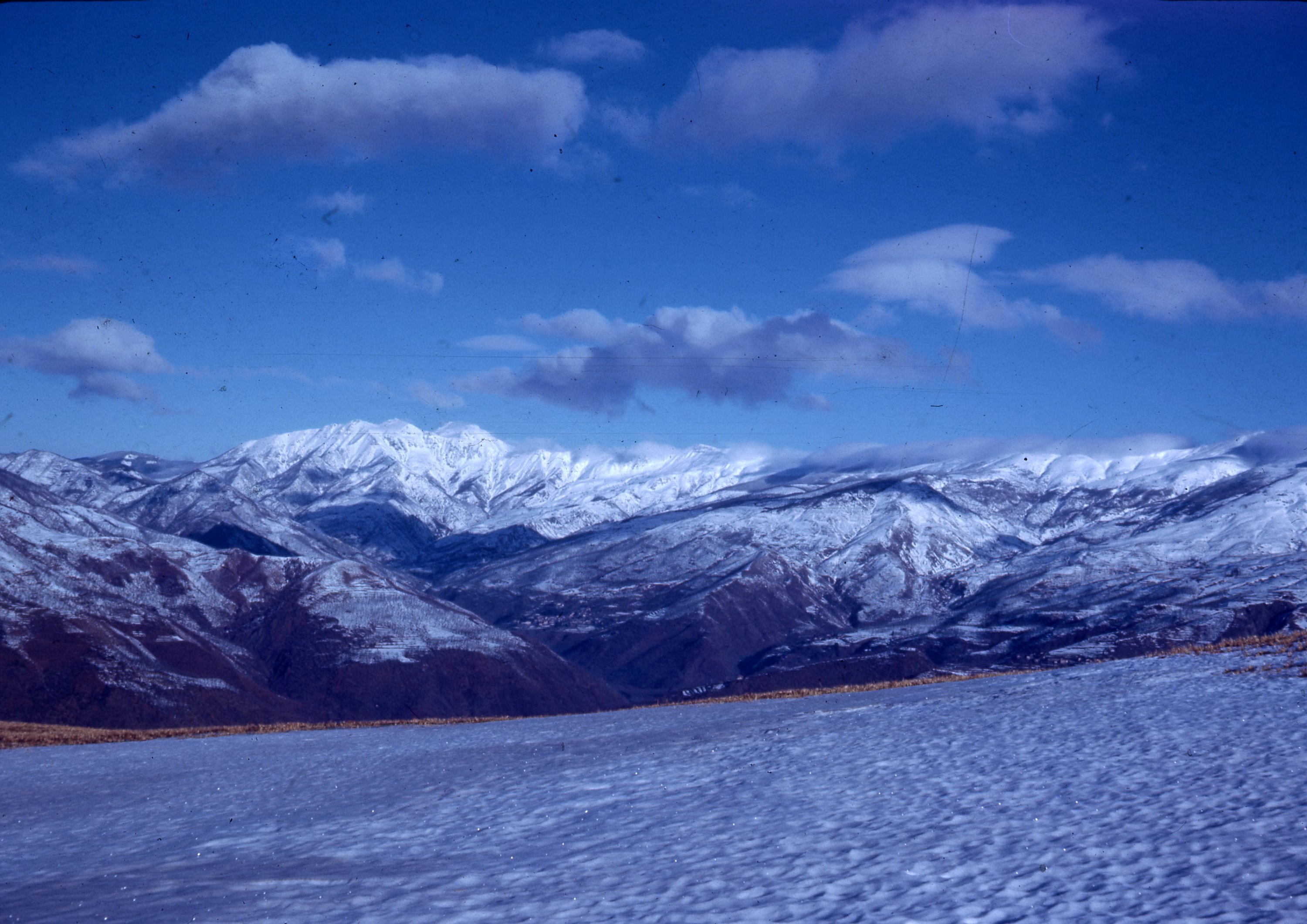
The Apennine Mountains, as photographed by a 10th Mountain Division soldier in early 1945.
Over a million Allied soldiers spanning Italy would launch an all-out assault on the last line of German defense. For the soldiers of the 10th, the coming offensive would be the final push out of the Apennine Mountains. Victory would mean that the end of the war was in sight. Dan Kennerly, a machine-gunner in the division’s 85th Mountain Infantry Regiment, noted in his diary that this would be:
…the last big effort. The war will soon be over…They are slipping the leash of the mighty Tenth. We can go as far and as fast as our abilities will take us.… In a few days we will be in the Alps drinking beer and chasing beautiful blonde Fräuleins.
Little did he know that the 10th Mountain Division was about to face its deadliest days.
Creating Mountain Troops
As war erupted in Europe in the fall of 1939, Chief of Staff General George C. Marshall was tasked with modernizing and expanding the US Army in the face of possible American entry into the conflict. Several early campaigns showcased the outsized impact of mountain- and winter-warfare units in challenging environments. In 1940 alone, headlines were replete with the exploits of military mountaineers and skiers: Finnish ski troops held off the invading Red Army for months in the Russo-Finnish Winter War, German mountain troops secured the Norwegian port of Narvik against tremendous odds, and Greek mountain battalions ground an Italian offensive to a halt. Aside from a handful of ski patrols conducted by National Guard units, the US Army had never developed any ski or mountain troops. Though Marshall and others knew this shortcoming had to be addressed, it was a daunting challenge to develop the equipment, skills, tactics, and doctrine essential to mountain and ski warfare. Fatefully, an offer of help from the National Ski Patrol arrived at just the right time.
Like many Americans, Charles Minot “Minnie” Dole was inspired by the performance of the Finnish ski troops. As the recent founder of the National Ski Patrol, Dole knew he was well-positioned to connect with the country’s most experienced skiers. In a unique agreement with the US Army, the National Ski Patrol became an official recruiting agency for a new unit of ski troops, utilizing its networks of ski patrols across the country to reach skiers of military age. The initial recruits, organized as a battalion at Fort Lewis, Washington, began developing the doctrine and requisite equipment for operating in mountainous terrain. By modifying existing outdoor equipment and working from translated European military manuals, the battalion developed the tools and skills of military skiing and mountaineering.
Over the next several months, the Army prepared to expand the initial battalion to divisional strength, and designated a remote valley in Colorado’s Rocky Mountains as its new home. In November 1942, the newly constructed Camp Hale (named for Spanish-American War hero and Denver resident Irving Hale) was ready to serve as the training grounds for America’s ski troops. The Fort Lewis battalion grew to become the 87th Mountain Infantry Regiment (MIR), and two more regiments, the 85th and 86th, were raised to flesh out the division’s infantry complement. With an additional three field artillery battalions and various divisional support units, the ski troops reached a strength of just over 13,000 men by the summer of 1943.
Activated in July 1943 as the 10th Light Division (Alpine), the unit’s unique designation led to considerable hesitation among theater commanders to request it for duty on their respective fronts. Its “light” and “alpine” designations, meant to reflect its operational flexibility, stemmed from its lighter (and fewer) artillery batteries, its mountain and skiing equipment, and its complement of pack mules. Theater commanders preferred to request regular infantry divisions, which had more personnel, bigger supporting artillery, and none of the encumbering tools (or mules) essential to mountain warfare. Aside from one temporary assignment for the 87th MIR—selected to help recapture the Alaskan island of Kiska—the war was threatening to pass by the soldiers at Camp Hale. Without an assignment, the 10th continued its training in the Colorado Rockies for another year before it relocated to Camp Swift, Texas in preparation for flatland training and a large field exercise. Rumors flew that the division would be broken up to replace losses other units suffered in the D-Day landings and in the Normandy campaign during the summer and fall of 1944. For a tense five months, it appeared the Army’s development of mountain troops had been an expensive failed experiment—then came a fateful request from a forgotten theater.
Hurry Up and Wait
With public attention focused on the dynamic island-hopping campaign against Japan and the steady progress against Nazi Germany in France, more than a million Allied troops fought in another theater that had slipped from the headlines: Italy. After successful landings in Sicily and the Italian mainland in 1943—and the controversial capture of Rome in June 1944—the Allied campaign ground to a halt in Italy’s Apennine Mountains, as German defenders used this challenging topography to their defensive advantage. Adverse weather, combined with this unforgiving mountainous terrain, had shattered several attempts to break through what was termed the “Gothic Line,” a makeshift German defensive line that ran from coast to coast. The commander of the American Fifth Army, Lieutenant General Lucian Truscott, was concerned not only about the lack of progress being made in Italy, but its negative impact on morale:
It is not hard to maintain morale when troops are advancing and winning victories….The end of December found the Fifth Army about as it had been at the end of October—when some confidence existed that the end of the war was in sight….Now those who had suffered the rigors of a campaign in the mountains the previous winter could only look to another winter campaign in higher and more rugged mountains under worse conditions of cold, rain, and snow. It was not a pleasing prospect[.]
For both the sake of the mission and morale, a breakthrough was needed.
Allied forces in Italy included the Brazilian Expeditionary Force, a Polish corps, numerous British Commonwealth forces, the 442nd Regimental Combat Team comprised of Japanese Americans, and an assortment of American infantry and armored troops. General Mark Clark, the American commander of the 15th Army Group to which all these units belonged, had been told not to expect any reinforcements as new divisions were more badly needed in other theaters. It was much to his surprise, then, that he received a call from General Marshall in the late fall of 1944 about the 10th division at Camp Swift:
[Marshall] had offered it to other theaters, but because it had special equipment instead of the regular infantry equipment, other commanders had turned it down. Later, in a conversation with Marshall, one of the commanders indicated that there had been a mistake in regard to the message of refusal and that he would like to have the division. ‘You’re too late,’ Marshall told him. ‘I asked Clark if he wanted it, and almost before I could turn around I got a message back saying to start it moving.’
Finally, after months in the Texan summer heat, the men of the 10th were to become mountain soldiers again. As they prepared for transfer to Italy, the division was rechristened to the iconic name by which we know it today: the 10th Mountain Division.
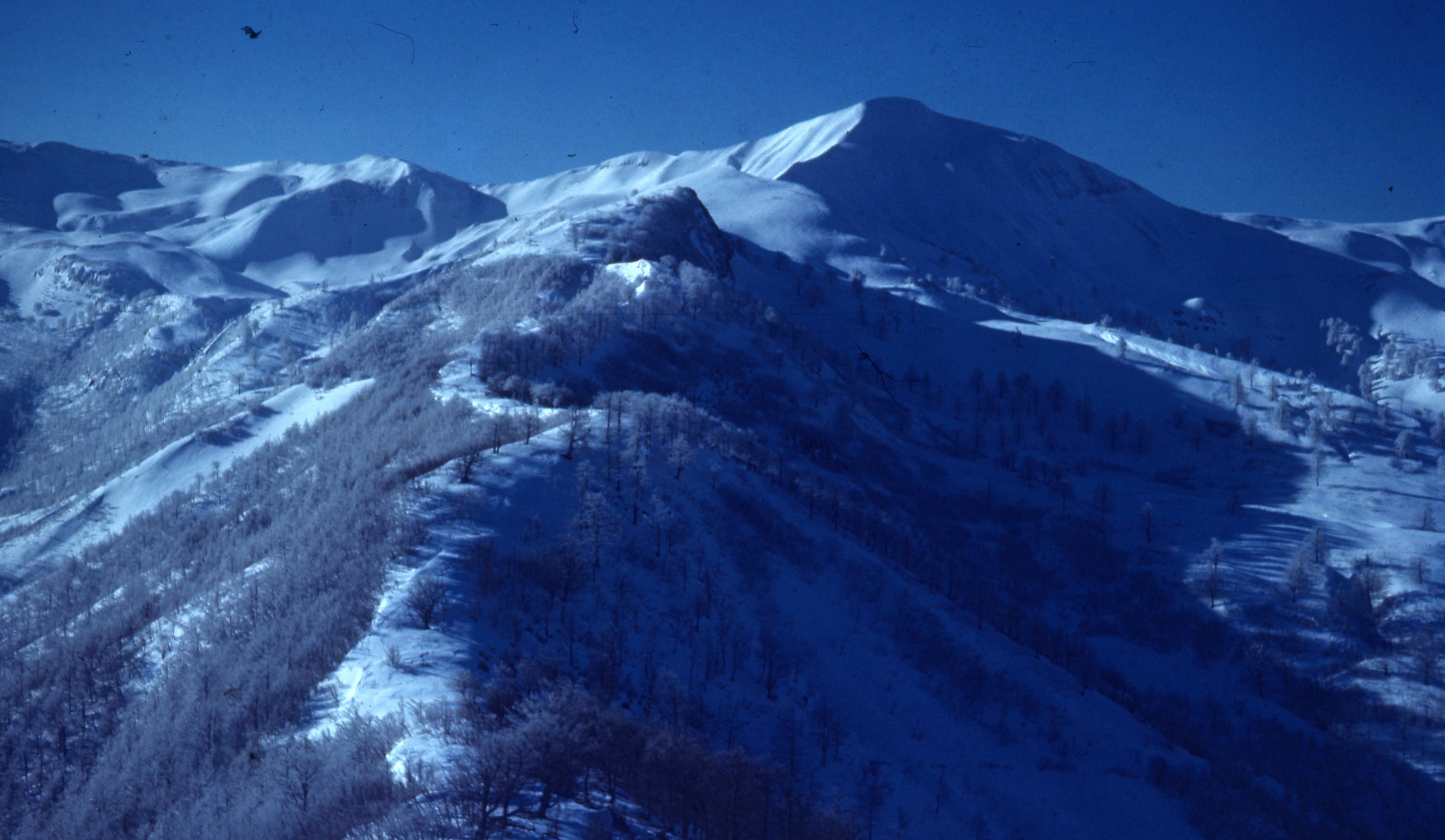
A view along the top of Riva Ridge, as photographed by a 10th Mountain Division soldier shortly after the battle.
Though the 10th was unquestionably an elite division with years of advanced training under its belt, it was untested under fire. Major General George Price Hays, a veteran artillery commander and First World War recipient of the Medal of Honor, was chosen to lead the division, partly due to his recent combat leadership experience and partly because the incumbent commander, Major General Lloyd Jones, had fallen seriously ill with bronchitis. Hays’s first introduction to the division was anything but a glowing review:
[General John Lucas] told me that his staff had inspected the 10th and that there was some ill feeling and discontent in the Division.…He said I had two good Colonels of Infantry and one not so good. I asked him who he had in case I wanted to replace one of my Colonels. He said no one. I said then I better do with what I have.
In Hays’s estimation, part of the problem lay with Jones’s illness; Jones presumably had been unable to prop up waning morale due to his prolonged absence. The primary problem was surely the rumor that the division was to be broken up after spending years training as an elite force. Tellingly, morale recovered quickly once the division was headed for Italy.
Hays was satisfied by the look and conduct of both his men and their officers, and assured them all that he would make it his policy to “make everyone as comfortable and to have as good a time as possible as long as we accomplished our missions.” General Truscott later remarked about Hays that he was “one of the ablest battle leaders” he ever knew and that he “fitted the Division like a well-worn and well-loved glove.”
Arriving in Italy
Perhaps unsurprisingly, German perspectives on the Italian theater mirrored the Allies’ own: The front was of tertiary importance to strategic planners concerned about other theaters, and the only reason to keep fighting there was to tie up enemy forces. German theater commander Field Marshal Albert Kesselring had a sober view of his prospects in central Italy, and repeatedly requested permission to withdraw to prepared defensive lines farther north. Hitler steadfastly refused. Though the inevitability of piecemeal German withdrawal was seemingly clear, his default defensive plan was to fight for every last inch of territory. Even so, German morale was surprisingly high. They were, after all, the final barrier between the Allies and their hometowns in Austria and Germany, and thus knew they had to hold out as long as possible.
While still adhering to orders to hold every feasible position, Kesselring prepared for a fighting retreat. Units were instructed especially in techniques aimed at containing any Allied armored breakthroughs before they could become catastrophic. To reorganize and redeploy men separated from their units in the chaos of a major offensive, divisions organized collection points to maintain as much combat effectiveness as possible. Of growing concern were anti-German partisans who posed a threat to supply and communication lines, and who constantly harassed troops across occupied northern Italy. German intelligence soon verified that Field Marshal Alexander ordered this increase in activity in preparation for new offensive actions in the spring.
Meanwhile, breakthroughs in other theaters motivated German High Command to shift divisions away from Italy. Kesselring, aware of the pressures elsewhere, offered to draw down to an even smaller force if it meant shoring up defenses in France and the East. But Hitler still considered it essential to hold northern Italy. In addition to satisfying his default “not one inch back” defensive plan, keeping troops in Italy was meant to secure some limited arms and food production facilities left to the Germans in the Po River valley. Allied commanders believed a general German withdrawal from Italy was a possibility, and thus ordered the parallel transfer of five British divisions to reinforce Field Marshal Montgomery’s force in France.
While the 10th was embarking on trains headed for the East Coast to board transports bound for Naples, Hays made his way to Italy by plane to consult with his new superiors and await his men. In a meeting with General Truscott, he learned that the 10th was to take Mount Belvedere, an imposing mountain that the Allies had failed to capture in three separate offensive operations the preceding autumn. When Hays asked Truscott who would “share the bullets” during the attack, the latter responded “no one;” the 10th would be on its own.
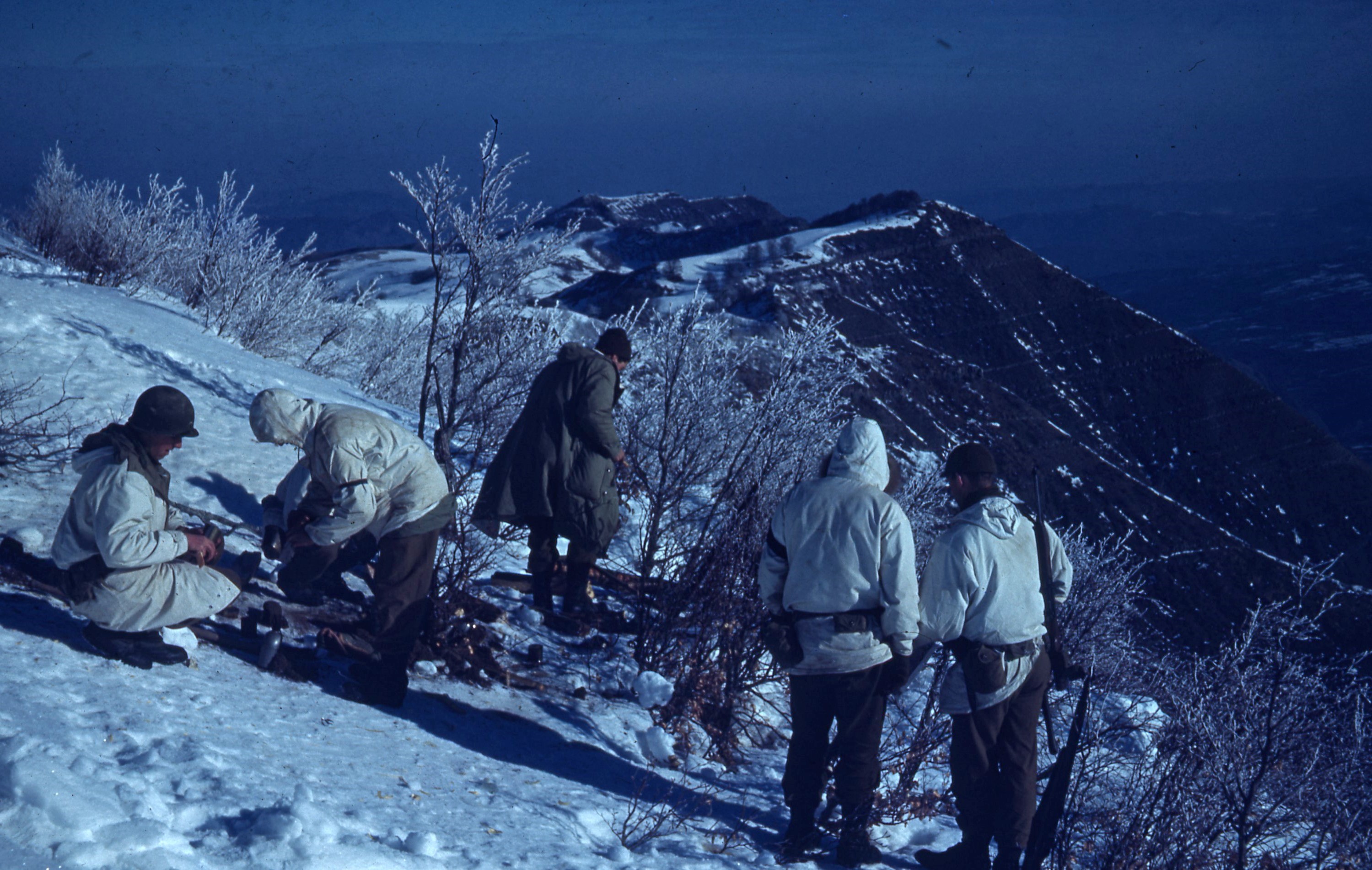
Soldiers of Company F, 86th Mountain Infantry Regiment, on Riva Ridge after its capture.
Upon the division’s arrival in Italy, it was assigned to hold an area near Monte Belvedere, but without immediate offensive action. This was by Hays’s personal request, to acclimate the 10th to frontline service in a quiet sector—and give him a chance to get to know his division—before their baptism by fire. The pause also gave Hays and his staff time to make their own assessments of the terrain and the impending assault. They would hold this position into early February, at which point planning for the offensive began in earnest. Occasional patrols skirmished with their counterparts on the German side during this time, and the division began suffering its first combat casualties.
Hays and his staff soon determined that the key to capturing Monte Belvedere and the reason prior attempts had failed was a ridge running to its west, soon code-named Riva Ridge. Considered unclimbable from the steep side facing the Allies, it was home to a series of lightly-defended German observation bunkers with excellent sightlines on the approaches to Monte Belvedere. From this vantage point, observers had called in devastatingly accurate artillery and mortar fire on the assaulting Allied troops in previous attempts to capture the mountain. Hays decided that taking the ridge and these bunkers would be critical to the success of any further action.
The element of surprise would be paramount. The Germans would not expect an attack on the ridge, as no Allied troops previously in the area had had the necessary skills or equipment for such a daring assault. Nevertheless, the Germans had well-established routes on the back side of the ridge, which meant they would have a much easier time reinforcing and counter-attacking once they realized the 10th’s daring plan.
On the night of February 18, soldiers of the 86th MIR assembled at their staging areas at the base of Riva Ridge. Under cover of darkness, they made their way to four routes previously identified by their best climbers (a fifth route was abandoned when it was found to be too treacherous). The surprise was complete—they captured the top of the ridge with only a single casualty, securing the observation bunkers that had been so critical in the defense of Monte Belvedere. With these in hand, the soldiers of the 85th and 87th successfully assaulted Monte Belvedere the following night. Over the next week, both positions held against repeated German counterattacks, and the 10th had successfully punched a hole in the German Gothic Line. The division had been bloodied in the intense fighting, but performed remarkably well, and demonstrated that their training gave them the upper hand in this mountainous terrain.
Accolades for the soldiers and commanders of the 10th poured in from all sides: from Truscott, that “the 10th Mountain Division in its first operation has been an inspiration to the entire Fifth Army,” from Clark, that the victory “speaks more eloquently than words of the efficiency of your pre-battle training and the spirit of officers and men,” and from Field Marshal Harold Alexander, the Supreme Allied Commander in the Mediterranean, the “heartiest congratulations…for a very well-planned and well-executed operation.” In 10th Mountain Division lore, these dramatic victories at Riva Ridge and Monte Belvedere are legendary. Their names even grace ski runs at Colorado’s Vail Ski Resort, founded after the war by a trio of 10th veterans, and the thoroughbred “Riva Ridge” won the 1972 Kentucky Derby and Belmont Stakes. It was an astounding victory and one for which no other division in the US Army possessed the skills or equipment. But as intense as the fighting had been for the 10th, it was only the beginning of their harrowing campaign through the Apennines.
Hays urged Truscott to build on the momentum gained at Monte Belvedere by pursuing the enemy and denying the Germans the chance to fortify their next defensive lines further. His request was refused, as other elements of Fifth Army were not yet ready to participate in a follow-up attack. This decision, Hays believed, made his division’s task more difficult and “caused us a good many more casualties.” Even some of the soldiers, who were rotated to the local rest center and given the chance to bathe and refresh themselves during this time, were irritated by the delay—or, more precisely, the mandatory training and seemingly endless hours in fox holes that would fill their schedules for the next several weeks. At the same time, elements of the 10th conducted limited objective assaults to secure another line of heights to prepare for the upcoming offensive. Referred to as the March Offensive, these short-but-intense attacks captured various heights, including Monte della Spe, which would become a jumping off point for the 85th MIR in the next offensive.
The time of relative quiet along the 10th’s front also gave occasion to at least one unusual display of humanity. Observers from the German 114th Jäger Division reported on March 11 of an impromptu and unapproved cease fire. Several Americans had descended from Monte Belvedere under a Red Cross flag and were met by a German soldier holding a similar flag. The German was seemingly a medic who chose to ignore orders from his regimental leadership to attack allied soldiers. When a German lieutenant, seeing his men ignoring the order to attack, attempted to end the ceasefire on his own, he was disarmed by his own men. Before either side was able to resume hostilities, a growing number of Americans and Germans had met in the valley, shaken hands, and transported away some of their dead who had been left behind after previous engagements.
In early March, Kesselring informed his division commanders that the probing attacks of the preceding weeks and days were the lead-up to an upcoming large-scale offensive across the line. He emphasized the importance of holding (and, if neutralized, retaking) prepared positions, because their abandonment would mean a difficult and dangerous retreat over the open ground of the Po River valley. Morale, which had still been high earlier in the year, was starting to wane, as the losses in February and March and increasingly troubling news from the Western and Eastern Fronts dogged soldiers and officers alike.
The Spring Offensive
Preparations were underway for Operation Grapeshot by early April, 1945: the drive north towards Bologna and the Po River valley. What would become known as the Spring Offensive was a general advance for the entire Allied front line cutting across northern Italy. The British Eighth Army would launch their eastern push on April 9, with diversionary attacks and preparatory bombardments in the days before, while the American Fifth Army was to begin their assault on April 12. Part of IV Corps, the 10th Mountain Division was on the left flank, with the Brazilian Expeditionary Force to its left and the American 1st Armored Division to its right. Unsurprisingly, the 10th was assigned the most mountainous section of the line and was tasked with capturing a series of heights (and nearby towns) that would help secure a highway running north towards Bologna.
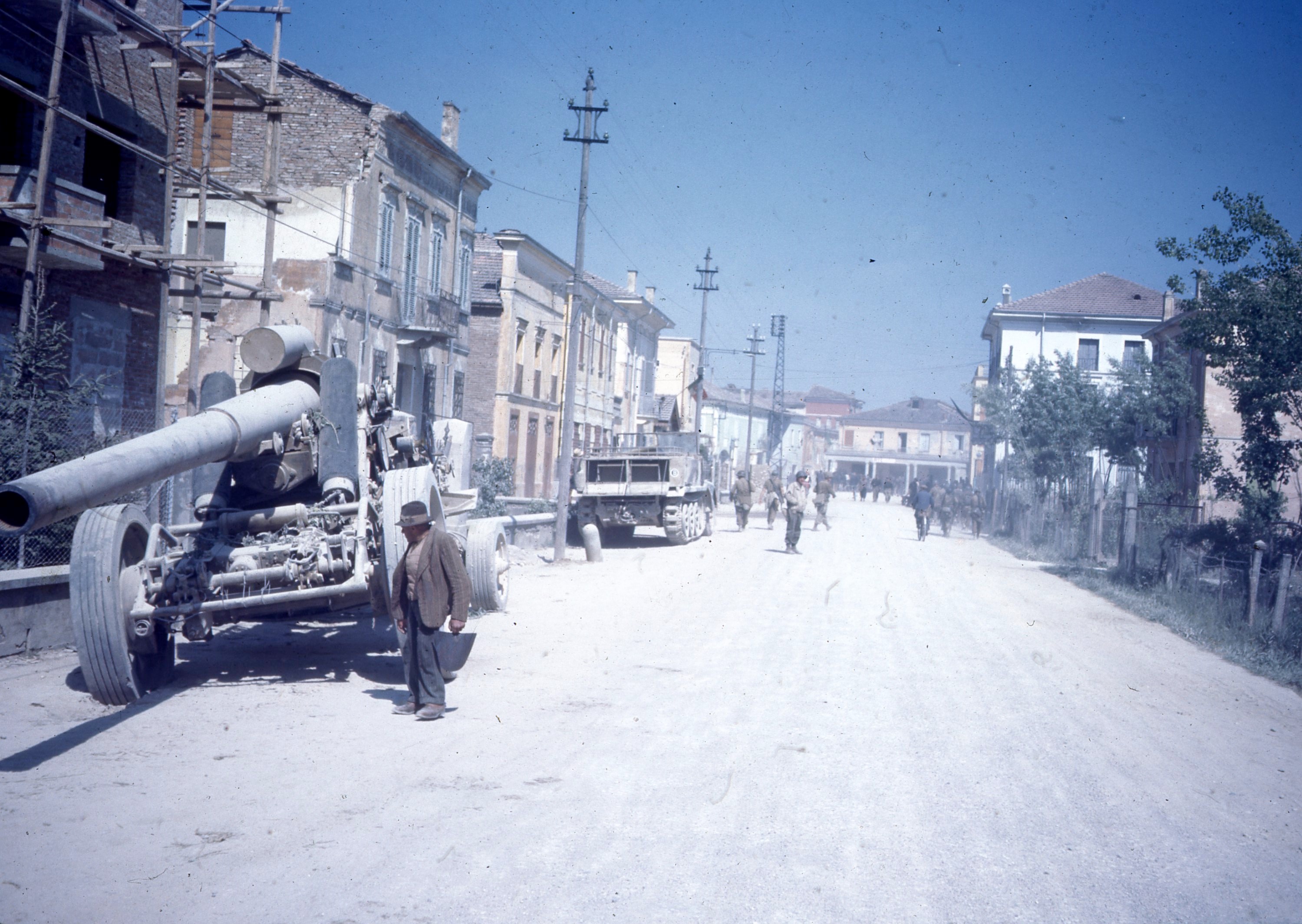
“Jerry droppings.” Abandoned German equipment photographed by Ralph Hulbert of the 86th Mountain Infantry Regiment.
The 10th’s main objectives lay to the east, which Hays assigned to the 86th and 87th Mountain Infantry Regiments. Concerned about a flank exposed to a possible counterattack, he instructed the 85th to push north across a valley to capture hills 909 and 913, which would preclude any counteroffensive action.
The men of the 85th knew they would bear the brunt of the fighting. Every guiding precept of the successful February assaults was abandoned for this new offensive: It would be launched midmorning, rather than at night, and an opening artillery barrage and air attack would soften the enemy positions at the cost of the element of surprise. Worse still, poor weather delayed the attack by two days, though preparatory artillery barrages had still been fired since April 10; there was thus no doubt the German defenders knew what was coming—and soon.
Excessive fog grounded support aircraft on the mornings of April 12 and 13. The morning of April 14 did not look any more promising. Truscott waited alongside a battery of telephones for reports from the airfields: “Still fogged in. More Coffee.…Still fogged in.…More coffee…” until the fog started to clear from the ends of runways and “flight after flight is reported airborne.…We cheer.” The attack was on. Dan Kennerly in the 85th’s reserves had a “grandstand view” of the opening act of the Spring Offensive for 10th Mountain Division, as sortie after sortie of aircraft dropped their payloads and the artillery chimed in:
“The noise is deafening. The grandeur of the moment is overwhelming.…The smoke and dust rise several hundred feet in the air and is billowing out in all directions. It looks like a huge fog bank.…Now the whole area is obscured. We can see only a few hundred feet to our front.”
Just as the fog was beginning to clear from the valley, it was replaced by the dust and smoke of the overwhelming opening barrage. By 9:45, the fire lifted and the troops were moving out.
The 3rd Battalion of the 85th launched their attack on Hill 913. Initially they advanced without much resistance, as the dust and remaining fog obscured them from enemy spotters. Once they broke through the haze, however, mortar fire began raining down on the advancing troops. A group of soldiers from Company L reached the top of Hill 913 but were forced to withdraw due to continued friendly bombardment of the position.
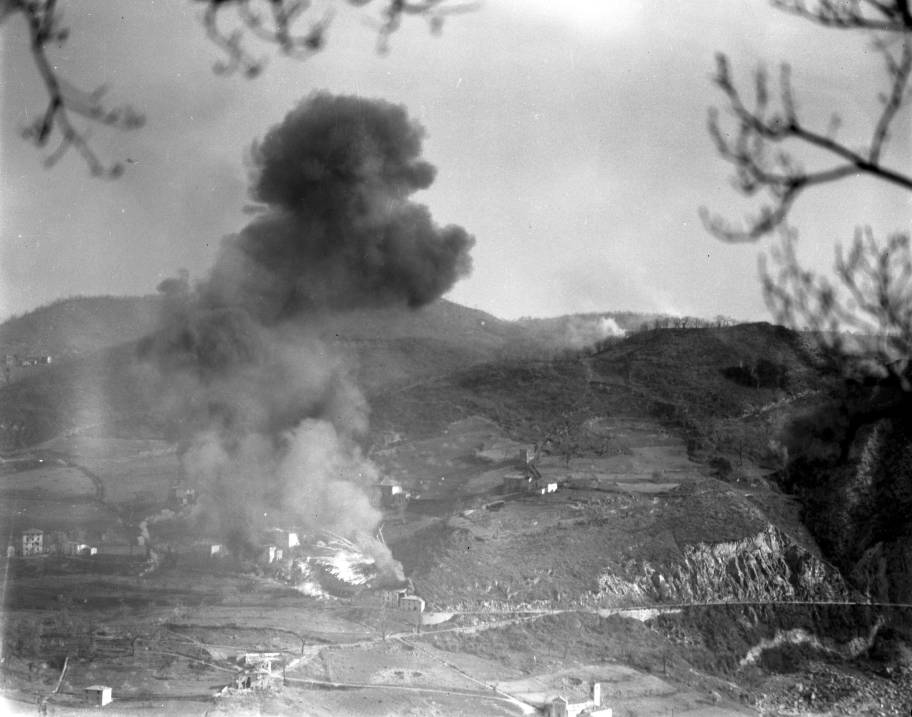
Artillery bombardment on the opening day of the Spring Offensive on April 14, 1945.
Small groups continued to hold the position throughout the late morning but clearing the enemy proved difficult and costly. German snipers, who had been bypassed in the opening assault, now started picking off soldiers one by one. Company I suffered heavy casualties, including amongst its officers. Lieutenant Keith Kvam, the weapons platoon leader, stepped on a landmine, while Lieutenant John Mitchell, a rifle platoon leader, was killed by an enemy sniper. Later senator and presidential candidate Lieutenant Bob Dole was so seriously wounded by enemy fire that he was at first presumed a lost cause by the soldier who found him. As Dole would later recount at 10th Mountain Division reunions, the soldier administered morphine he had taken from a killed medic and used Dole’s blood to draw a large letter “M” on his forehead to ensure he would not be given a second, potentially-fatal dose. Against all odds, Dole survived, but suffered from the results of his wounds for the rest of his life.
By 12:30, Company I had suffered so many losses that the battalion commander ordered Company K to assist. Snipers, landmines, and mortars continued to take their toll, as more men and officers of Companies K, L, and M were killed or wounded in their attempts to secure the hill. Finally, at 2:30 in the afternoon, the hilltop was secured. As the minefields continued to hold up supporting armor elements, 3rd Battalion clung to the hill, unable to push the advance further. They dug in for the night. Murray Mondschein, a medic with the 85th, later wrote home that “913 made Belvedere look like kindergarten.”
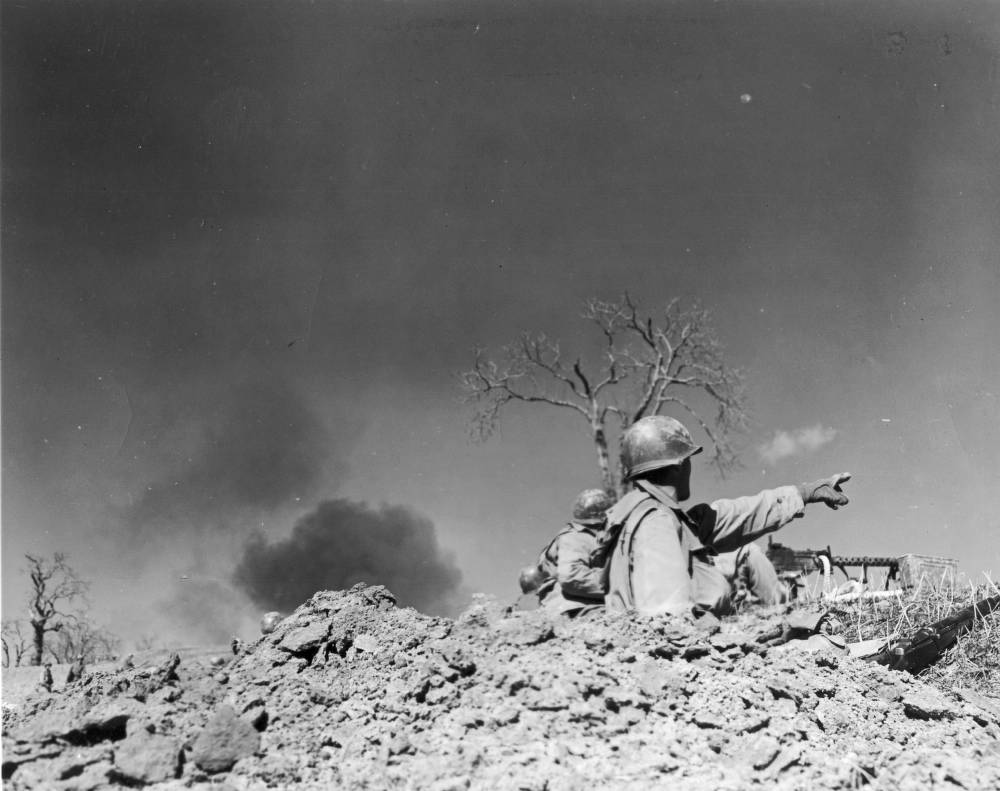
Soldiers of Company K, 87th Mountain Infantry Regiment, advance under fire.
Things were not faring better on Hill 909. The 85th’s 2nd Battalion launched their attack at the same time as the 3rd, and quickly ran into heavy resistance. Unlike Hill 913, which was primarily plagued by indirect fire and snipers, the men at Hill 909 were in direct contact with the enemy, trading heavy machine gun and small arms fire as they advanced. A young soldier from Norwalk, Connecticut, Private First Class John Magrath, volunteered to act as a scout against the entrenched Germans. He single-handedly captured a machine-gun nest and used the captured gun to neutralize two more. He then volunteered again for the dangerous task of assessing friendly casualties and was killed in action. He would later be awarded the Congressional Medal of Honor for his heroism, the only soldier of the 10th Mountain Division recognized this way during World War II. Through the remaining daylight, the battalion fought its way up Hill 909 and dug in to prepare for a long night.
The unexpected holdups on 909 and 913 had implications for progress made by the 86th and 87th MIR’s, which depended on a secure flank to proceed to their easterly objectives. The 87th was pinned down near the town of Torre Iussi, where they met unexpectedly heavy resistance. Hays ordered elements to bypass the town and flank the defenders, giving the others the chance to proceed to one of their main objects, the massif of Rocca di Roffeno. Both regiments were forced to dig in for the night as the 85th had, short of their planned objectives and anxious about possible counterattacks.
The soldiers of the 10th expanded the footholds gained on April 14 the following day, fighting off fierce resistance to secure their objectives and clear lanes for a general northern advance. Truscott seized the opportunity and directed 1st Armored to punch through the openings created by the 10th. With troops now advancing all along the line, German resistance began to crumble into a general retreat towards the Po River. It was the beginning of the end.
Contemporary observers and generations since have marveled at the doggedness of German defense this late in the war—and in Italy, of all places, which seemed so relatively remote in comparison to the Eastern and Western Fronts advancing on Germany itself. In addition to the factors identified by Kesselring earlier, some captured intelligence offered additional clues. Among some prisoners taken from the 775th Infanterie Regiment (334th Infanterie Division), interrogators found a diary revealing that the defenders had been told an attack from the 10th Mountain Division was imminent and that they would take no prisoners. Their fear was further confirmed by Kennerly, who received the hesitant surrender of a German on April 15. The soldier had waited in a bunker with his severely wounded comrade for more than a day before daring to surrender to the first American he spotted without a weapon—Kennerly was carrying supplies at the time.
The Aftermath
The fighting during those brutal days of April pushed the German defenders out of their last prepared positions south of the Po River. From there, it was a chase to the river and beyond. The 10th Mountain Division advanced with speed, soon reaching Lake Garda. Even this close to the end, tragedy struck daily, as the division continued to suffer casualties until the Germans laid down their arms. On April 30, just two days before the end of fighting in Italy, an errant German shell exploded among some gathered officers and senior non-commissioned officers, killing the legendary founder of the US Army Rangers, William Darby. Darby had replaced Robinson Duff as the Assistant Division Commander just a week before. Finally, on May 2, a broadcast authorized by Generaloberst Heinrich von Vietinghoff informed German defenders that an unconditional surrender had been signed and would take effect at 2:00 that afternoon. Though Clark credited his Army Group for militarily defeating the Germans in Italy, this capitulation was ultimately arranged by clandestine negotiations in Switzerland between a high-ranking SS general and Allen Dulles of the Office of Strategic Services, a precursor of the CIA. The fighting in Italy had been brought to an end a full week before the rest of Europe.

A pontoon bridge under construction which will carry the division across the Po River.
Thousands of German prisoners of war started pouring into allied hands. Among them were the dozens of generals who had commanded the fighting retreats of the 10th and 14th Armies. Clark was eager to learn what he could from these leaders and had them gathered in a villa, “wired for sound from top to bottom.” To encourage uncareful conversation, cases of whisky were delivered to the villa with the desired effect. Amid grumbling about Hitler’s micromanagement and astonishment at his suicide, the generals “showed amazement at the offensive power in the mountains developed by the American divisions, particularly the 10th Mountain Division.”
The soldiers of the 10th had cause to celebrate. In an episode remembered fondly in numerous memoirs, they even stumbled on the necessary supplies to commemorate the end of the fighting in Italy:
A detachment of the Fifth Army passing through Bolzano, [Heinrich] von Vietinghoff’s headquarters, found carefully stored away in a deep cavern thousands of cases of fine French champagnes and liqueurs. Each bottle was carefully stamped in German: ‘STOCKS RESERVED FOR GERMAN ARMED FORCES ONLY.’ You can imagine how much attention we paid to that. The wines were distributed to the men of the Fifth Army, and few needed any water for the next couple of weeks.
The soldiers were intent on enjoying peace while it lasted; many suspected they were bound for the Pacific for the impending invasion of Japan. After some occupation duty, including a blocking action in eastern Italy to forestall any invasion from Tito’s Yugoslavian partisans, the division embarked on transports headed for the American East Coast. En route, they received word of the atomic bombs dropped on Hiroshima and Nagasaki; they would not be heading to the Pacific after all.
In just over three months of combat, 999 men of the 10th Mountain Division were killed in action. More than 4000 were wounded. They had helped punch a hole through the last German lines of defense in Italy and perhaps contributed to the early end to the fighting in that forgotten theater, but at tremendous cost. The three opening days of the Spring Offensive in April were the most devastating: 286 killed in action, 1047 wounded, and three taken prisoner by the enemy, accounting for roughly 30 percent of the division’s total casualties on campaign in 1945. From the spectacular double victories at Riva Ridge and Mount Belvedere to the harrowing March and Spring Offensives, the 10th Mountain Division’s fateful fight in the Apennine Mountains had brought movement back into the Allies’ campaign in Italy, breaking through the German defenses and bringing an earlier end to the fighting. Though Italy is often overlooked in general histories of the war, the soldiers of the 10th Mountain Division were vital in the effort to defeat German and Italian fascism, and still loom as larger-than-life heroes in the Italian mountain towns they liberated.
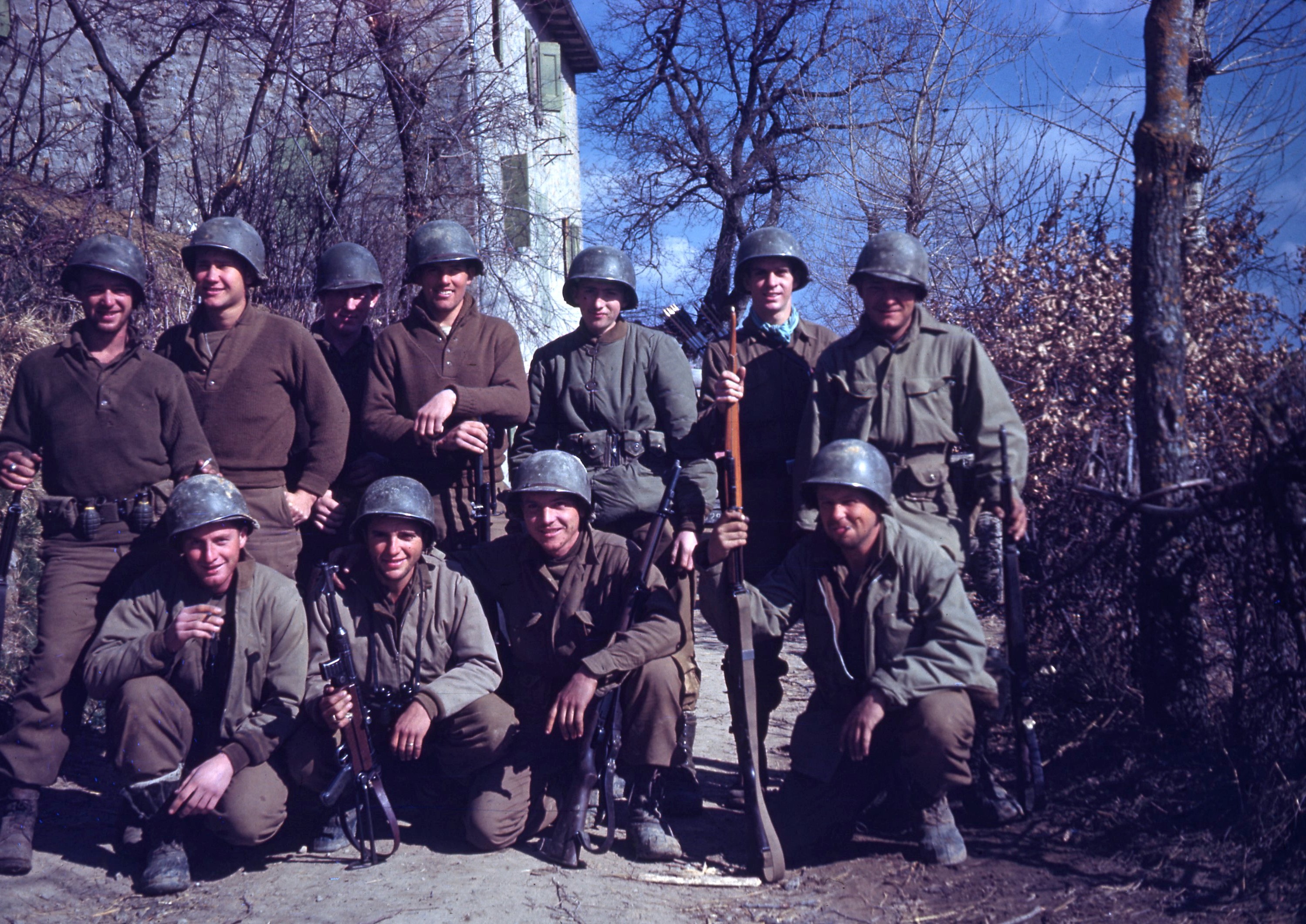
A squad of Company F, 86th Mountain Infantry Regiment, after a patrol. The camera’s owner, Ralph Hulbert, is second from the right in the top row.

